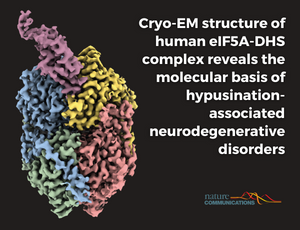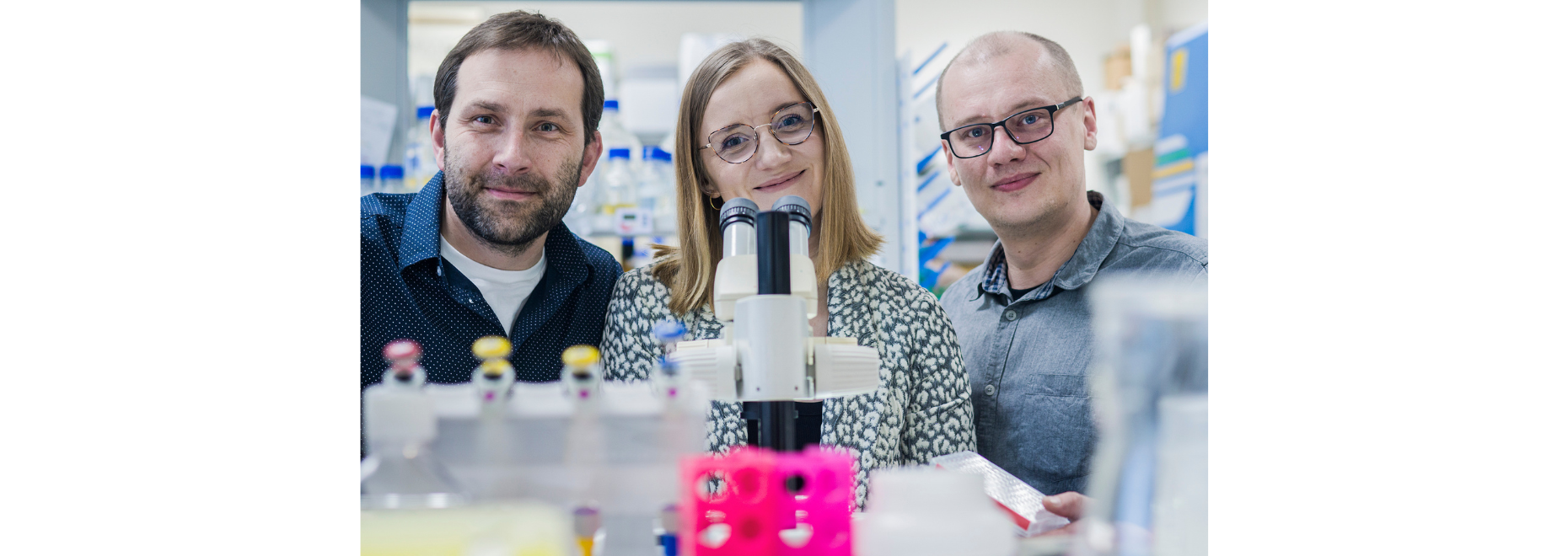
 Web Content Display
Web Content Display
SOLARIS centre
 Web Content Display
Web Content Display
 Web Content Display
Web Content Display
Molecular Details of eIF5A Hypusination and Clinical Relevance of DHS Mutations

Researchers from the MCB, Jagiellonian University, are at the forefront of studying the most unique posttranslational modification in the human proteome.
A research team from the Małopolska Centre of Biotechnology (MCB), Jagiellonian University, led by Dr. Przemysław Grudnik, has made a groundbreaking discovery that reveals the missing link in the molecular mechanism of hypusination. The team solved the atomic structure of the eIF5A-DHS complex which explains how a specific lysine residue within eukaryotic translation factor 5A (eIF5A) is converted to hypusine. Hypusination is the most unique posttranslational modification and has only been described for a single protein. The hypusination process is carried out by two enzymes – deoxyhypusine synthase (DHS) and deoxyhypusine hydroxylase (DOHH). The modified eIF5A is critical for numerous cellular processes, including cell growth and division.
First identified in the 1980s, hypusination has attracted growing interest ever since. Despite the increasing number of published experiments linking alterations in hypusination levels with various human disorders, the molecular mechanism of this modification remained elusive. "Hypusination is a little-known, but essential process for every living cell. During my university curriculum, I never heard about this unique process, and only my supervisor Dr. Przemysław Grudnik introduced this term to my dictionary. I am really happy that we were able to broaden our understanding of the molecular mechanism of hypusination. By revealing the detailed structure of the eIF5A-DHS complex, we have gained new insights into how DHS recognizes and modifies eIF5A," says Elżbieta Wątor, a PhD student at the Małopolska Centre of Biotechnology and the lead author of the article.
Fig.1. Cryo-EM structure of eIF5A-DHS complex
The team employed a combination of multiple techniques, such as X-ray crystallography, cryo-electron microscopy, and hydrogen-deuterium exchange coupled with mass spectrometry, to obtain an accurate and detailed model of the reaction. Biochemical and biophysical analyses complemented and verified the structural data, providing insight into DHS loss-of-function mechanisms linked to a recessive rare disorder. "Application of X-ray crystallography allowed us to visualize and analyze fine structural rearrangements taking place along the catalytic cycle of DHS. However, we were not able to visualize the interaction between eIF5A-DHS.Fortunately, Cryo-EM, allowed us to complete the picture by determining the complex of DHS with its substrate protein bound. Our study is a great example of the potential of structural biology in explaining long-standing biological questions," says Dr. Piotr Wilk, the second author of the article.

Fot.1. Main authors of the article. From the left: dr Przemysław Grudnik (corresponding author), Elżbieta Wątor (first author) and dr Piotr Wilk (second author).
Samples for structural studies were prepared at the Structural Biology Core Facility at MCB JU. Cryo-EM data were recorded using the Titan Krios G3i high-end cryo-electron microscope located at the SOLARIS National Synchrotron Radiation Centre. Diffraction data collection was performed at the BESSY II synchrotron at MX-beamlines 14.1 and 14.3.
"The understanding of eIF5A-DHS interaction could have implications for the development of new treatments for diseases related to aberrant protein translation, such as cancer and neurodegenerative disorders. We aim to further exploit our structural understanding of the deoxyhypusination complex to develop new chemicals targeting it," adds Dr. Przemysław Grudnik, the corresponding author of the study.
Hypusination studies at MCB are funded by NCN OPUS-17 (“Molecular basis of hypusination” UMO-2019/33/B/NZ1/01839) and NCN PRELUDIUM-18 (“The protein with two faces - characterization of a dual-activity deoxyhypusine synthase from Trichomonas vaginalis” 2019/35/N/NZ1/02805) projects.
The research article is available online:
